Peperomia plants (radiator plants) are popular tropical plants known for their thick stems, fleshy leaves, and ornamental foliages. The compact design makes this houseplant ideal for desktop, shelf, and windowsills.
There are over 1500 peperomia species available for indoor and outdoor gardens. These indoor plants thrive in warm locations or near a radiator. Besides that, these peperomia types have distinct features for easy identification.
My favorite peperomia varieties are obtusifolia, argyreia, orba, ferreyrae, and hope. These types of peperomia plants are super easy to grow and maintain. They flourish in well-draining potting soil and moderate to bright indirect sunlight.
With so many different radiator varieties to choose from, it can be challenging to pick the perfect species. Read this peperomia varieties chart to help in making the right decision before adding any of the species to your indoor plant collection.
You May Also Like: How to Care for Peperomia Plants
25 Types of Peperomia with Pictures and Names
Peperomia Argyreia
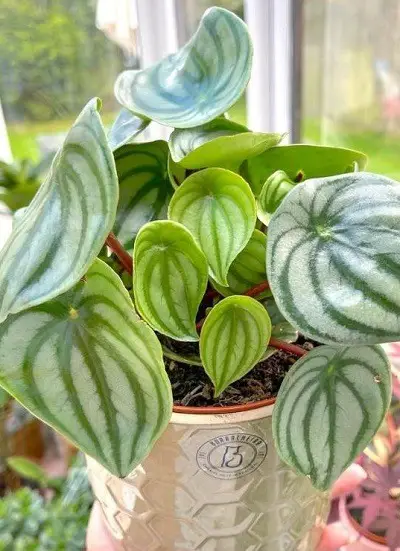
The species is also known as watermelon peperomia due to its large, heart-shaped, green leaves with silver stripes that look like the skin of watermelon fruit.
The foliages are attached to stunning red stems that grow as a bushy rosette. The traits make this houseplant suitable as a ground cover or grouped with other indoor plants.
It does not belong to the rare peperomia varieties due to its availability in various plant stores across the country. But growing and caring for watermelon peperomia is not ideal for beginners.
Peperomia argyreia care involves moderate moist soil, bright indirect sunlight, well-draining potting mix, and warm condition.
Peperomia Obtusifolia
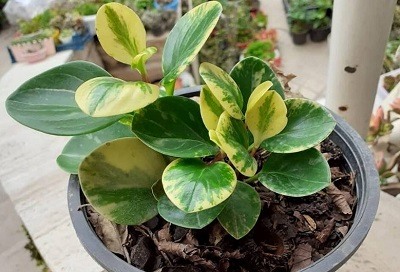
The species is also called a baby rubber plant. It is a small and bushy succulent-like peperomia species with tall upright stems. The glossy and slightly concave evergreen leaves are incredible.
The plant grows up to 20-30cm tall at maturity. Besides that, it comes in several cultivars with creamy-white leaves, dark green and ivory variegation.
These cultivars make the species the best on the peperomia varieties chart. It is also easy to grow and maintain regardless of an individual experience.
Peperomia obtusifolia care involves the provision of bright indirect sunlight, high humidity, regular watering, and well-draining soil for root aeration purposes.
Peperomia Orba
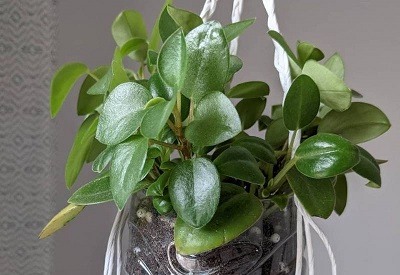
The species is commonly known as the teardrop peperomia plant. The trailing variety tends to stay perky and fresh throughout the year.
It cannot overgrow the spaces since it maxes out about 6-inches tall and wide. It has small oval-shaped foliages that are glossy and slightly fuzzy with crisp indentation along the midrib.
The teardrop peperomia is the most inexpensive peperomia variety. It is also available in several cultivars such as Pixie Lime, Astrid, and Variegata.
Peperomia orba care entails the provision of bright indirect sunlight, consistent watering, well-draining soil, and high humidity. The semi-succulent stem implies less watering to prevent overwatering.
Peperomia Ferreyrae
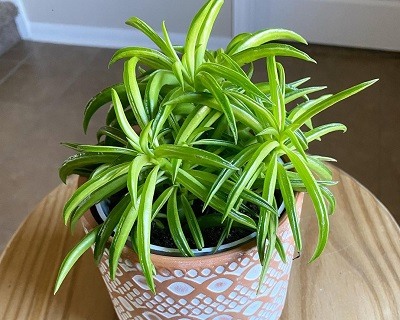
Ferrayrae belongs to the succulent peperomia family. It is the easiest to grow and maintain regardless of an individual experience.
The species has a cluster of green bean-shaped foliages to bring out a compact design. The peperomia variety is a perfect choice for desktop and windowsills.
The compact design also helps the plant boost humidity around it. I recommend growing this peperomia species in a small pot since it cannot easily overgrow the pot.
Peperomia ferrayrae care entails the provision of high humidity, moderate soil moisture, and bright indirect sunlight. The well-draining potting medium also enables the plant to thrive well.
You May Also Read: 20 Beautiful Philodendron Varieties with Pictures
Peperomia Hope
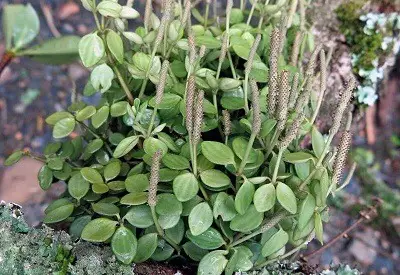
It is also known as acorn peperomia or four-leaved peperomia. The species is ideal for hanging baskets (Check Best Deals on Amazon) in my peperomia varieties chart.
The variety has long trailing stems with thick oval foliages. These leaves usually grow in a bunch of three to four to make a bold statement in any space.
The most popular cultivars are peperomia deppeana and quadrifolia. These hope hybrids make the species lovable in the United States.
Peperomia hope care consists of well-draining soil, bright indirect sunlight, high humidity, and a moderate watering routine. The average height for this species is about 8-12 inches.
Peperomia Ruby Cascade
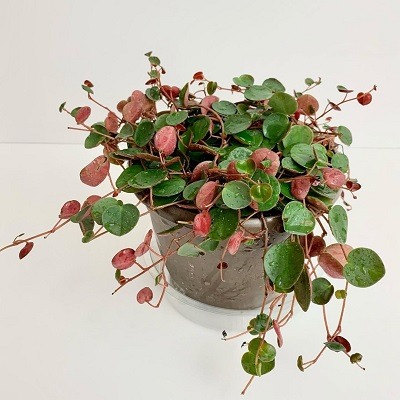
It is a fast-growing peperomia species with small and rounded foliages with green surfaces and red hues undersides. It is an excellent splashy hanging plant.
The stems grow upright and topple as the plant reaches two feet long. The trailing makes this species among my favorite peperomia types.
The ruby cascade has undocumented lineage making it among the rare peperomia varieties. But the houseplant is popular in North America.
Peperomia ruby cascade care includes the provision of bright indirect sunlight, high humidity, and well-draining potting soil. It can also tolerate an arid interior without becoming fussy.
Peperomia Tetragona
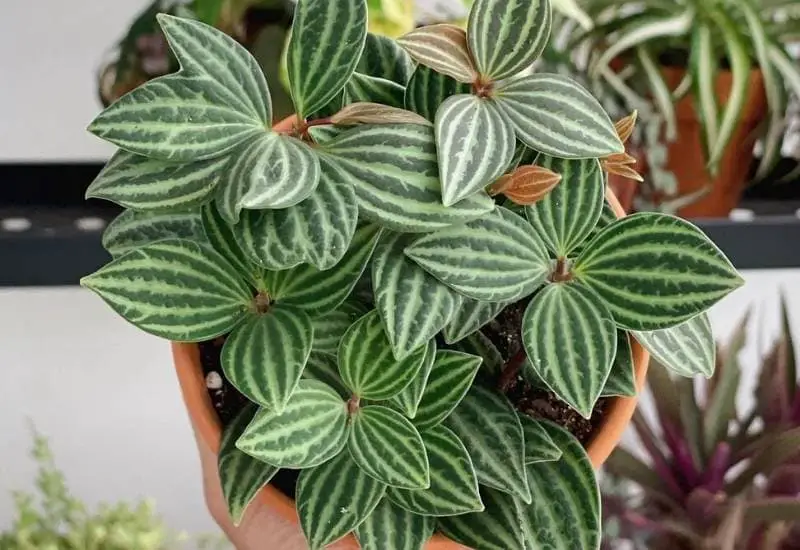
It is also known as parallel peperomia or peperomia puteolata. The species has almond-shaped leaves with alternating thin strips of green and off-white that run along the midrib.
Parallel peperomia has semi-tropical features that can tolerate average humidity. But the provision of higher humidity allows the houseplant to flourish well.
The species start to grow upright as it topples after reaching two feet long. Trimming helps to grow the plant short suitable for hanging planters. (Check Best Deals on Amazon).
Peperomia tetragona care entails the provision of bright indirect sunlight, average humidity, a consistent watering regime, and well-draining potting soil.
Peperomia Graveolens
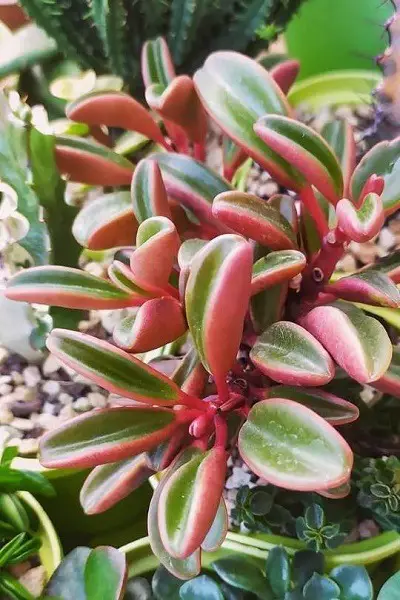
It is a succulent-like peperomia species with thick fleshy leaves and a compact design. The tongue-like foliages have a deep crease down the center to result in a v-shape.
The leaf surface is light green with pink edges and pinkish-red undersides. The peperomia species is native to Southern Ecuador. Besides that, it is super easy to grow and care.
Peperomia graveolens care involves the provision of bright indirect sunlight, a minimal watering routine and well-draining soil. The plant can grow up to 25cm tall.
You Might Also Like: 15 Best Calathea Varieties with Pictures
Peperomia Clusiifolia
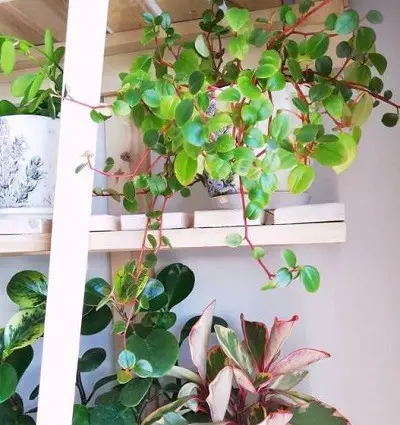
The species is also known as the peperomia jelly plant. The indoor plant has unique multicolored foliages that make a bold statement in any space.
The leaves have green centers with cream-colored stripes that fade to pink and then red along the edges. These colorations make the houseplant suitable for desktops and shelves.
The colorful pointed oval foliages result in other plant names like tricolor peperomia, red edge peperomia, and ginny peperomia. It is the most beautiful peperomia variety in the market.
Peperomia clusiifolia care involves the provision of well-draining soil, bright indirect sunlight, and moderate watering. The condition allows the plant to attain its full potential.
Peperomia Caperata Emerald
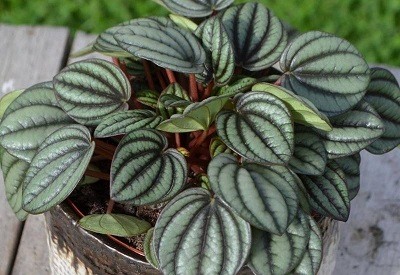
It is the most beautiful peperomia caperata cultivar. It is also known as the emerald ripple peperomia caperata. It has eye-catching foliages with a corrugated appearance.
The cultivar has a lush dark red or almost purple color than other species have silver-grey with red blushing. The compact design makes it ideal for tabletop or shelves.
The emerald ripple peperomia care involves the provision of bright indirect sunlight, moderate watering, and high humidity. Well-draining soil helps to enhance roots aeration.
Peperomia Albovittata
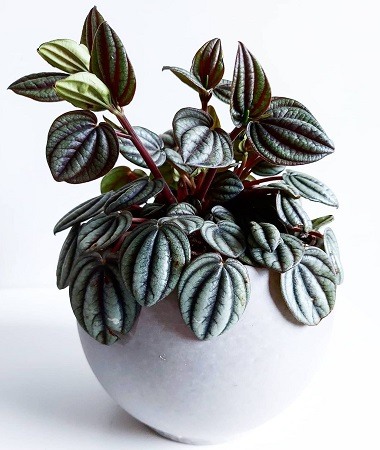
It is also known as piccolo banda. The species has a skyrocketing demand in the market due to its reddish and longitudinally indented veins on a pointed oval vein.
The striking foliages are attached to an upright petiole with a shade of tan and rose. These foliages and stem colorations make a bold statement.
Peperomia albovittata care entails the provision of bright indirect sunlight, high humidity, and well-draining soil. The semi-succulent leaves allow the plant to tolerate drought for some days.
The peacock peperomia is sold as Ivy leaf, emerald cultivar, Rana Verde, and Rosso in many plant stores in the United Kingdom. It is affordable and readily available.
Peperomia Rubella
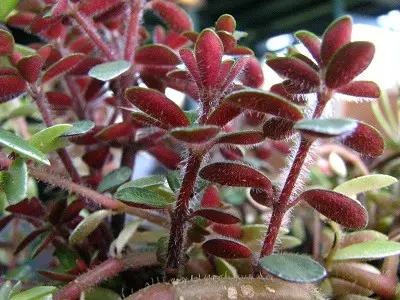
The species is native to the Jamaican jungle. Rubella has petite foliages emerging from sturdy and scarlet stems. Each fleshy leaf has green surfaces and red undersides.
The peperomia rubella grows up to 4-5 inches before toppling to become trailing. Simple pruning help to keep the plant upright.
Peperomia care involves the provision of bright indirect sunlight, high humidity, moderate soil moisture, and a well-draining potting mix. The best species for terrarium display.
Rubella is also known as bitsy peperomia and it is sold as peperomia cubensis. The species is readily available in many plant stores across the country.
Peperomia Axillaris
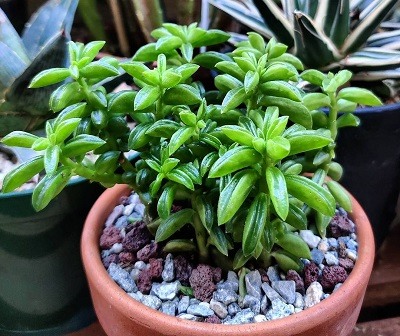
Axillaris resembles ferryrae but the foliage appearance is what makes a huge difference. The species has bright green foliages that look like a stack of bean pods.
Besides that, axillaris are taller than those lookalikes. It can grow up to 10-inches tall. The plant also tends to lose lower foliages and leave a cluster of foliages at the top of the stem.
The stems grow upright up to some point and later topple, making the plant ideal for hanging baskets (Check Best Deals on Amazon).
Peperomia axillaris care involves the provision of bright indirect sunlight, well-draining soil, and moderate moisture. Trimming is necessary since it helps the plant to grow into a bush-like form.
You May Also Read: 20 Stunning Aglaonema Varieties with Pictures
Peperomia Perciliata
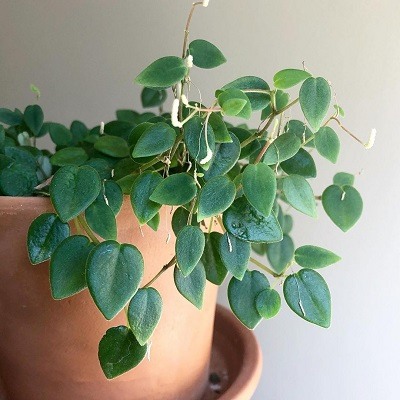
It is the most unique peperomia variety in the world. The species has small, heart-shaped fuzzy foliages with reddish trailing stems.
The tight multiple stems with close-sets and dark-green oval foliages make this species ideal for hanging baskets. The prolific stems also make the plant an excellent ground cover.
Besides that, these species produce long white flowers with a sweet fragrance. The tropical plant is native to Colombia and Panama rainforest.
Peperomia perciliata care entails the provision of medium bright indirect sunlight and average humidity level. The plant also thrives in terrariums.
Peperomia Incana
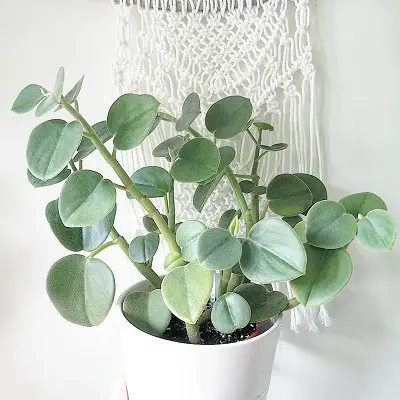
Incana is also known as felted pepper face due to its lookalike with pepper plants. The species has succulent round foliages covered with pelt-like fuzz.
The fuzz gives the leaves a special white shine in certain angles of the light. Besides that, the fleshy stems have a fuzz cover.
Peperomia incana care involves the provision of bright indirect sunlight, high humidity, and a well-draining potting medium. The plant is non-toxic to pets and humans.
Peperomia Quadrangularis
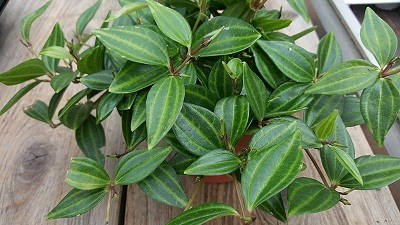
Quadrangularis is my favorite peperomia species. It has sports faint pinstripes on small oval foliages with squared semi-succulent stems.
The stripes on foliages are light green over a dusky green background. The light green foliages can darken under intense natural sunlight.
The peperomia species is also known as Angulata or Beetle peperomia. It is a slow-growing epiphyte without extensive roots.
The plant thrives under moderate to bright indirect sunlight, average humidity, and well-draining potting mix. It is also highly vulnerable to root rot due to overwatering.
Peperomia Prostrata
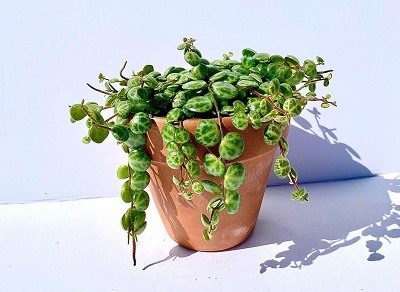
The peperomia species have reddish stemmed trailing with small round fat foliages covered with shiny translucence. The springy red-hue stems make this species a hanging masterpiece.
It is a slow-growing tropical plant with green surfaces and undersides. It also comes in several cultivars like the spring of turtle which has round foliages with exotic mottling.
Prostrata thrive in bright indirect sunlight, well-draining organic materials, and moderate soil moisture. The species also belong to the rare peperomia varieties chart.
Peperomia Serpens
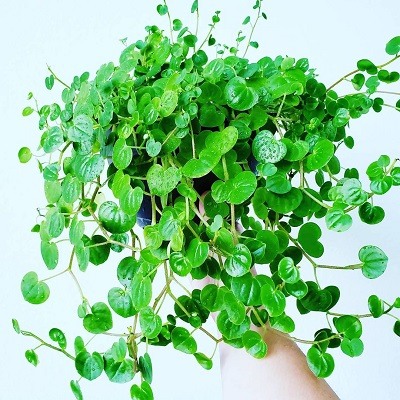
The peperomia usually confuses people with heartleaf philodendron or pothos. The cupid peperomia has perky vining features that resemble those lookalikes.
It comes with white to cream or yellowish splotchy margins on the foliages. The eye-catching foliages with ease to care regime happen to be the reason behind its popularity.
Serpens peperomia thrives in bright indirect sunlight and a slightly moist environment. The condition makes the species stand out from others in the clan.
Peperomia Dolabriformis
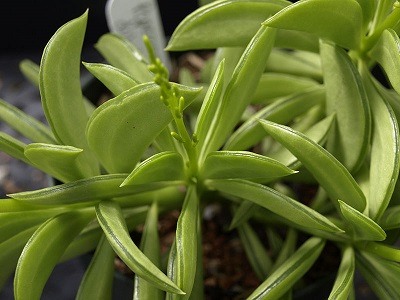
The species is native to the Peruvian Andes, where it thrives as an epiphyte in rocky fissures and trees. It is the smallest and succulent peperomia variety. It is also known as prayer pepper.
The plant has stubby, folded, and canoe-like foliages. Besides that, the species produce semi-woody stems at maturity. Maxi is eye-catching dolabriformis cultivars in the market.
Peperomia dolabriformis care involves the provision of moderate indirect sunlight and a slightly moist environment. The narrow translucent gaps help to regulate light illumination.
Peperomia Rotundifolia
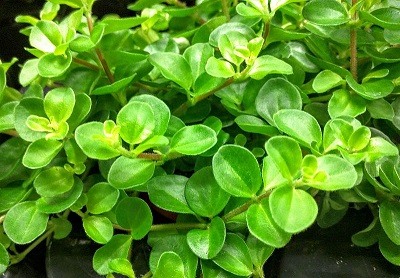
The peperomia species produces several vines that carry small fuzzy round foliages with subtle light veining. The stems grow upright when short to create a full bushy pot.
The stems usually grow long if not kept trimmed to form trails on the pot. These trails tend to intertwine to form a thick drape. These features make the species look like a jade plant.
Rotundifolia has succulent leaves that foster low water requirements. Besides that, the peperomia species is also called trailing jade and jade necklace.
Peperomia Verschaffeltii
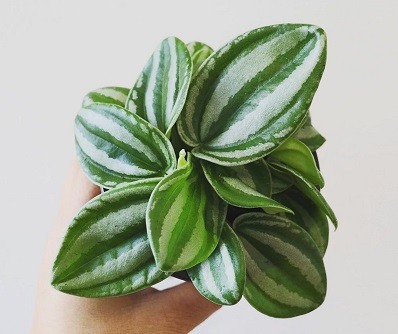
It is a dwarf watermelon peperomia also known as the sweet peperomia plant. It has oval fuzzy bluish-foliages with wide bands of silver on its surfaces.
The species is native to the Brazilian jungle and grows up to six inches tall. The red-tinted stems remain compact with overlapping leaves that grow to form a rosette shape.
The plant also produces thick spike blooms that resemble peace lily’s spathe. Besides that, the species thrive in porous soil with a moderate watering routine.
Peperomia Kimnachii
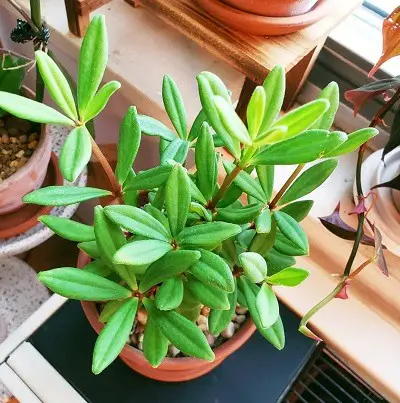
The species hails from the Bolivian rainforest with elongated semi-succulent leaves. The foliages form upright clusters around the leaf nodes.
The stems have a reddish tint that concentrates around the nodes. This decorative houseplant is popular and readily available in several plant stores in New York City.
Kimnachii can tolerate low light without becoming fussy. But this houseplant thrives well in bright indirect sunlight. Direct light may bleach the plant foliages.
Peperomia Verticillata
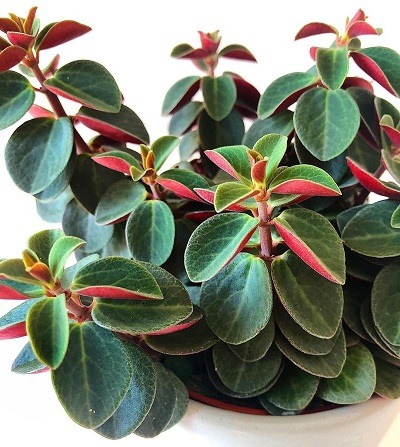
It is another outstanding peperomia species also known as a belly button or red log peperomia. It produces four small fuzzy oval foliages per cluster on a stem.
The stems grow upright and fall over under its weight. Each leaf has glowing green surfaces and red hues undersides. The species is a little bit bigger than other peperomias.
The verticillata species love bright indirect sunlight and regular trimming. The trim helps the plant form a two-tone bush. The plant also thrives in high humidity and moderately moist soil.
Peperomia Polybotrya
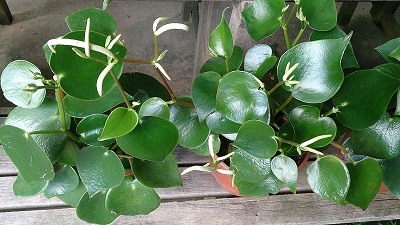
The peperomia cultivar has shiny, teardrop, green foliages arranged on the short and sturdy stems. It has a natural open bush structure and grows up o a foot tall.
Mature foliages can grow up to six inches wide. The peperomia species is also known as the raindrop or coin-leaf peperomia plant.
The tropical features make it easy to grow and maintain indoors. The floral style with single fat and floppy spike that emerge from the center of the leaves mark a bold statement.
Peperomia Elongata
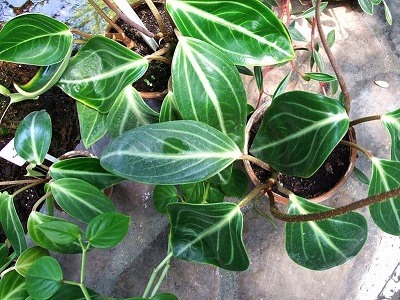
The peperomia species features wavy and ribbon-like succulent foliages. The leaves are shiny on the top surface and have furry undersides.
Each leaf has a white center midrib and lesser side veins that fade as the plant reach the tip. The stems are fuzzy with intriguing red mottling similar to obtusifolia species.
The spiky inflorescences are prominent and have vivid moron color. The peperomia variety does not tolerate a damp condition since it is vulnerable to root rot.
The peperomia elongata thrives in bright indirect sunlight and high humidity. It hails in the South American jungle. It is challenging to tell the difference from other related peperomia varieties.